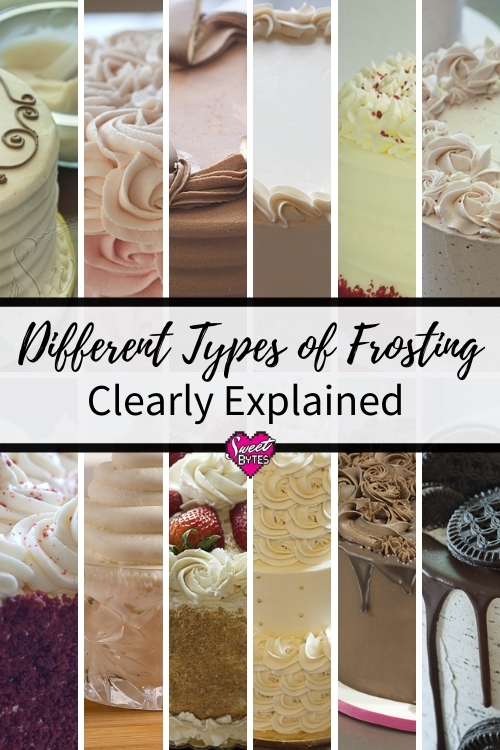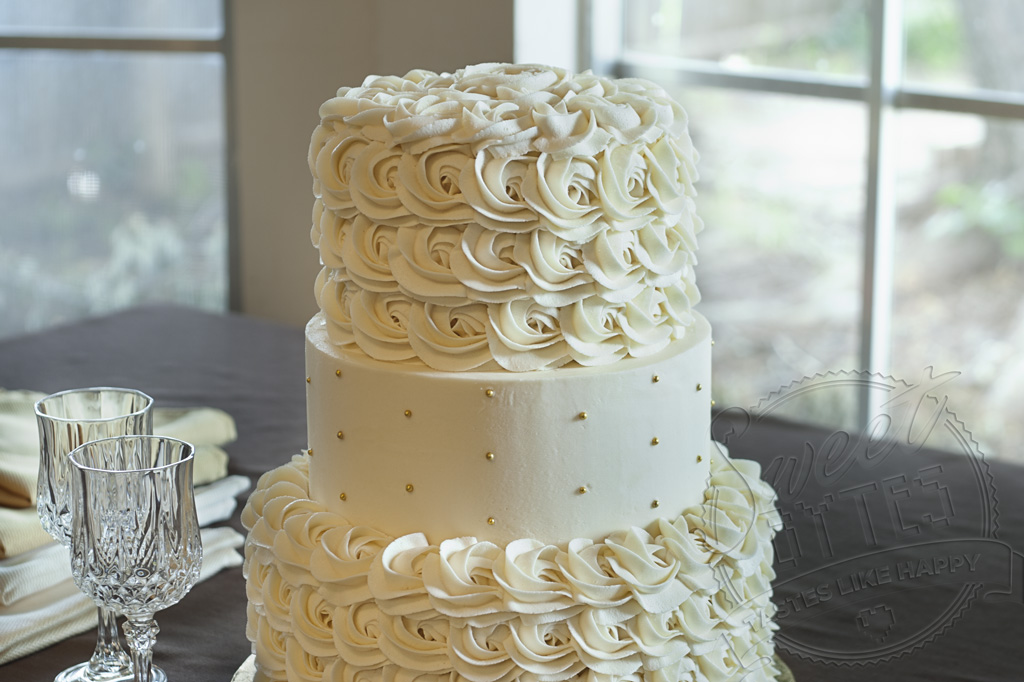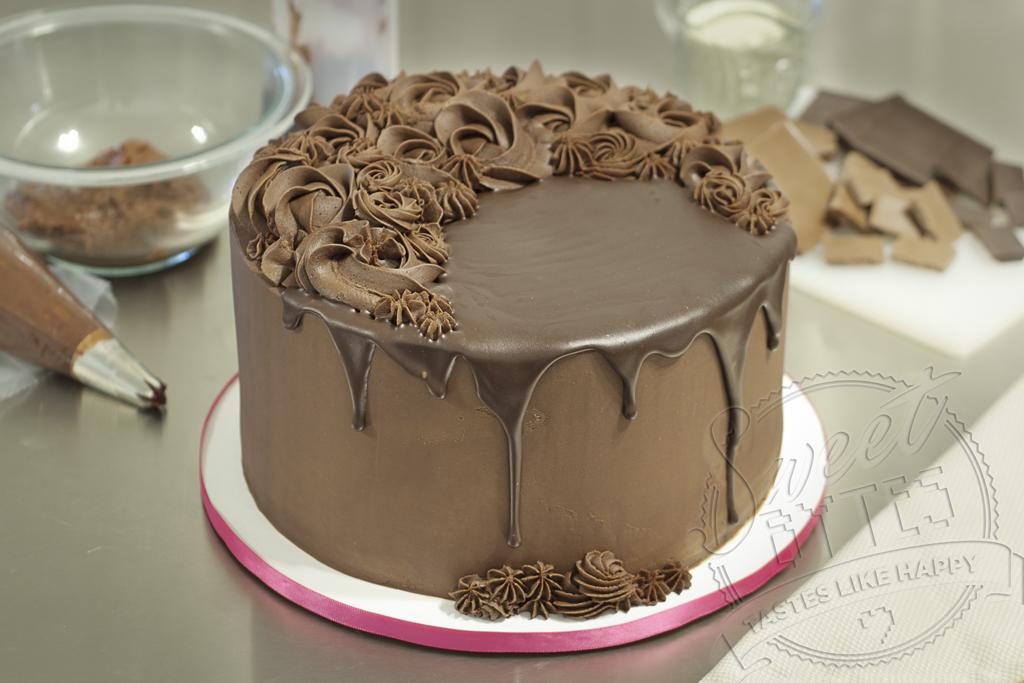Are you confused about the different types of frosting and when to use them?
Do you have questions about which frosting will work best for your cake or cupcakes?
Are you tired of being confused when cake decorators on TV talk about ganache this, SMBC that, French and Italian buttercream here, American buttercream there?
I am going to tell you everything you need to know about all the types of frosting, right here, right now! (At least all the kinds of frosting on my radar. The great thing about the baking universe is that is constantly expanding. I learn new things EVERY DAY! I am sure frosting updates are in my future.)
Are you ready? This is a LONG post, very informative, you might need to get comfy.
This post contains affiliate links.
Do you call it Frosting or Icing?
Do you even call it frosting? Some people call it icing… I guess it doesn’t matter to me. Really, I have no pet peeves about people calling it one or the other.
I say “frost the cake” instead of “ice the cake.” Perhaps, I consider icing the thinner, glaze that is drizzled or poured over desserts. Maybe icing has to dry to the touch and not be sticky?
Oh well, whatever you call it, let’s talk about it (and call it frosting- ha ha!)
Frosting is used to cover the cake, decorate the cake, and fill the cake. Frosting can also be used on any dessert, not just cake. It’s usually spreadable and comes in any flavor you can imagine.
There are different situations where certain types of frosting perform better than others. When you know the limitations of each type, you can exploit it however you need to. (Know the rules and then break them, right?)
Here’s an overview of the different types of frosting we will cover today:
- American Buttercream
- Cream Cheese Frosting
- Easy Buttercream
- Ermine Frosting
- French Meringue Buttercream
- Ganache Frosting
- German Buttercream
- Italian Meringue Buttercream
- Korean Shiny Buttercream
- Seven Minute Frosting
- Stabilized Whipped Cream Frosting
- Swiss Meringue Buttercream
American Buttercream:
AKA: Basic buttercream, ABC, sugary frosting, cupcake frosting, simple buttercream, crusting buttercream
I can’t speak for the “American-ness” of this buttercream, but I can explain what it is.
American Buttercream is a fat (butter), mixed with powdered sugar, flavoring, and a little liquid to get the consistency right.
Many recipes only use shortening and no butter. Still, many more will argue that if you are going to call it buttercream, it should have some butter. Personally, I am Team All Butter, All Day.
If you must use shortening, a secret of professional bakers is Hi-Ratio Shortening which whips up light and fluffy without the greasy mouthfeel of grocery store shortening. It also contains trans-fat and whatever you think of that is between you and Jesus.
Organic palm shortening, such as Spectrum Shortening is a great option.
The amount of each ingredient and the mixing time of each ingredient are where people really start to divide. Secret recipes and methods start emerging and this is part of the fun. A well-developed frosting recipe is a legacy that can be passed to the next generation.
My vanilla buttercream recipe is my very favorite tasting American buttercream. It pipes beautifully, is great for a filling or frosting and it can even be used under fondant. In fact, it’s the same buttercream I used to decorate the 3 tiered rosette cake in the photo above.
The pros of American Buttercream are:
- It’s very easy to make
- ABC is suitable for frosting, filling, or piped decorations.
- The only equipment you need is a bowl, spatula, and a mixer
- Uses simple ingredients that you might already have in your cabinet
- It is easy to color using AmeriColor Soft Gel Paste Colors
or other food-safe coloring
- Flavors changed easily using extracts, purees, emulsions, powders, zests, juices, liqueurs, curds, etc.
- The consistency can be changed from thick to thin easily for different uses
- Stable without being refrigerated up to three days
- You can make these types of buttercream in advance and store in airtight containers
- Crusts for ease of handling and making decorations
- Works under fondant
- Good for smooth sides and sharp edges
- Freeze for later use for several months
- Refrigerate up to two weeks
- Make in advance
The cons of American Buttercream are:
- Very sweet, can be overpowering to some people
- It is dense or heavy, in mouthfeel. It may not pair well with a more delicate cake or treat.
- Sometimes, it can be gritty because of the powdered sugar. Mixing methods and sugar amounts and quality of powdered sugar have to be adjusted to reduce this unpleasant texture.
- If made with all butter, it could begin melting in a warmer setting such as outdoors or under a direct spotlight.
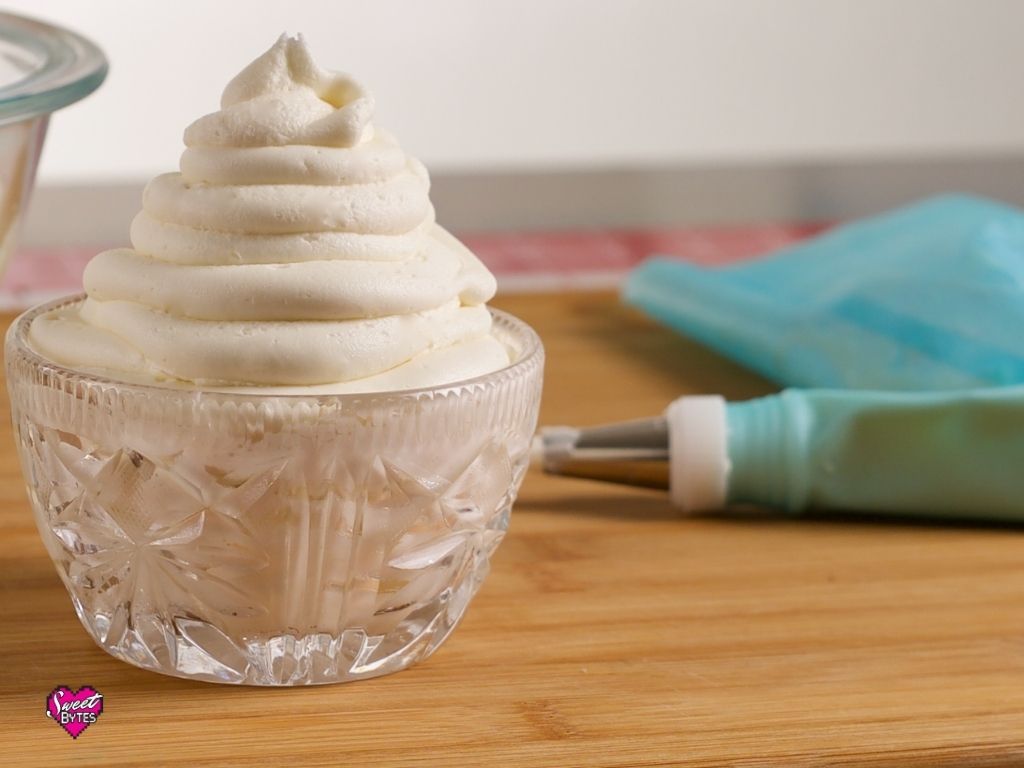
Cream Cheese Frosting:
AKA: Cream Cheese Buttercream
Cream Cheese Frosting is very similar to American Buttercream except for adding cream cheese. This is a very rich frosting, and it pairs well with spiced cakes, fruit flavored cakes… and, well, if you love cream cheese, all desserts.
Basically, to make cream cheese frosting you beat cream cheese, butter, powdered sugar, and vanilla to make a frosting. You can add milk or cream, or even more powdered sugar to change the consistency of the frosting for different applications, such as filling or piping.
Recipes vary the cream cheese to butter ratio, the mixing methods, and the other ingredients amounts. Some even have tips and tricks to add to make the cream cheese frosting hold up to conditions it doesn’t favor, like piping or use under fondant.
I have found that cold cream cheese frosting, will do what you tell it. Warm cream cheese frosting is only good for pouring on bundts and cinnamon rolls… and eating by the spoonfuls.
Here’s a link to my best-loved cream cheese frosting recipe.
You should also try my Chocolate Cake Frosting which is a chocolate cream cheese frosting/ American buttercream hybrid.
The Pros of Cream Cheese Frosting:
- It’s delicious
- Easy to make
- You do not need any special equipment other than basic baking supplies
- It colors easily with AmeriColor Soft Gel Paste Colors
or other food safe colorings
- The flavor can be changed easily with extracts, powders, emulsions, liqueurs, etc.
- Cream Cheese Frosting holds up well as a filling or frosting. It can also be piped, but I would test your recipe’s limitations before making it the star of a big event.
- Refrigerate for up to a week for later use
- Freeze for several months for later use
- Can be made in advance
The Cons of Cream Cheese Frosting:
- It does not hold up well under fondant (I know there are some recipes that claim they do but remember, I’m Team All Butter, All the Time and mine doesn’t. Here’s a recipe that claims it does: CakeBoss Cream Cheese Frosting )
- Piped decorations can soften and lose definition
- It is not stable for warm temps
- Needs to be refrigerated. (This too comes up for debate. Unless a food testing authority has tested for shelf life safety the recipe, I would refrigerate it because of the cream cheese.)
- Not great for sharp-edged cakes
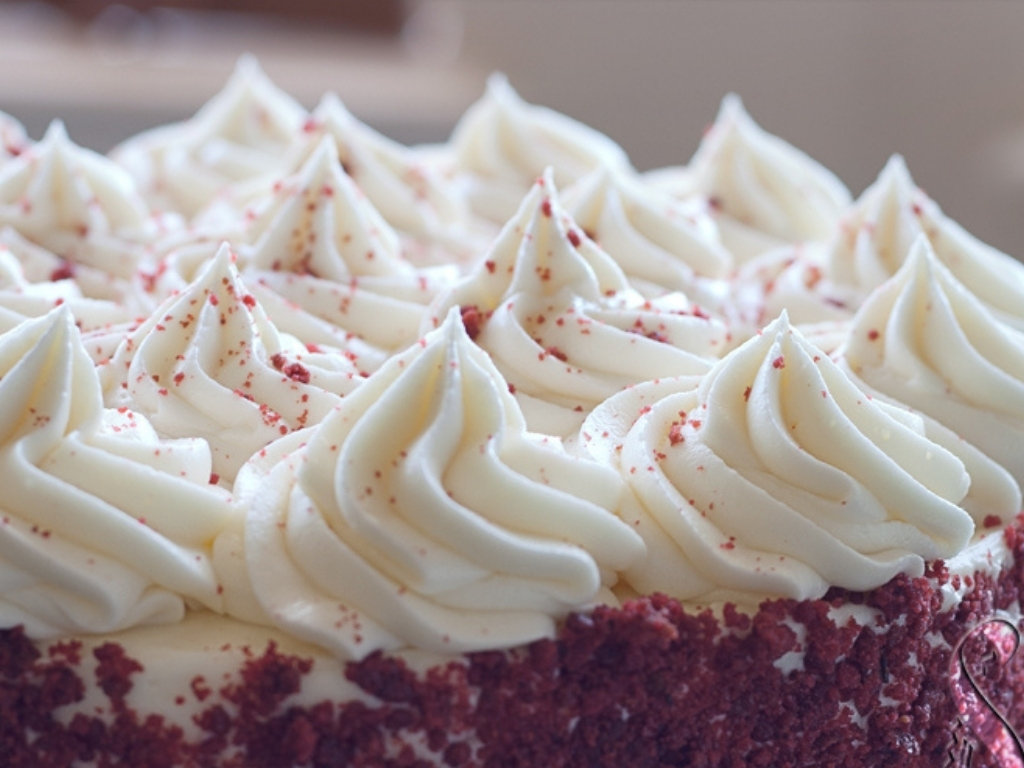
Easy Buttercream:
AKA: Lazy Swiss Meringue, Easy Swiss Meringue Buttercream
Easy Buttercream Frosting has been becoming more and more popular with famous names using it and touting that it has all the deliciousness and none of the fuss of real Swiss Meringue Buttercream.
I first heard of it while taking Mike McCarey’s Craftsy online class, Incredible Cut-Out Cakes. I couldn’t believe how simple it was to put together! Amazingly, it has the properties of more difficult Meringue Buttercream Frostings with zero fuss!
The base recipe is pasteurized egg whites and powdered sugar whipped together for 5 minutes, then butter added a bit at a time, flavor as desired. How easy is that? Of course, everyone adds their own special secrets, but it’s still EASY!
Liz Marek, Sugar Geek Show has also put together a wonderful tutorial and recipe on Easy Buttercream here.
The Pros of Easy Buttercream Frosting
- IT’S EASY
- Stable for all decorating applications
- Good for frosting, filling, or piping
- Silky smooth mouthfeel
- Light in texture and taste
- Not too sweet, pairs well with all cakes
- Easily colored with AmeriColor Soft Gel Paste Colors
- Flavors can be added easily using extracts, purees, emulsions, powders, zests, juices, liqueurs, etc.
- Use under fondant
- Great for sharp edges
- Shelf-stable at room temp for up to 3 days
- Freeze for months
- Refrigerate up to two weeks
- Make in advance
- No special candy thermometer, or double boiler needed
The Cons of Easy Buttercream Frosting:
- Use PASTEURIZED egg whites because there is no heating involved to kill salmonella
- Some people think it tastes too buttery. (Is that a thing? TOO buttery?)
- A stand mixer will make this job easier.
Ermine Buttercream:
AKA: Flour Buttercream, Flour Frosting, Cooked Milk Buttercream, Pudding Style Buttercream
This buttercream is pretty easy to make, like American Buttercream. It starts with a cooked flour, milk and sugar base (same as homemade pudding). This pudding is then cooled and later added to whipped butter with flavoring to make a delicious and very stable frosting.
This is an old-fashioned frosting that pairs well with cakes like Red Velvet (it’s the original Red Velvet Cake frosting) and others where you would regularly see cream cheese frosting. It’s not as sweet as American buttercream, but it isn’t light and airy like meringue buttercream.
The great thing about Ermine Frosting is that it is more stable than American buttercream, but you don’t have to mess with eggs like the European versions.
Flour Buttercream Recipe on Serious Eats is a good bet to get you started with Ermine Frosting and they ALWAYS do their homework so you get great recipes from them.
The Pros of Ermine Frosting:
- It’s fairly simple to make
- Common baking equipment and ingredients
- The flavor can be changed easily by altering the cooked base flavors
- You can use it as frosting, filling, or to pipe decorations
- Color easily with AmeriColor Soft Gel Paste Colors
- This frosting can be used under fondant
- Good for sharp edges
- It is not overly sweet
- It’s fun to try an old-fashioned recipe (Yes, this is big fun. Everybody’s doing it.)
The Cons of Ermine Frosting:
- It takes more time than American Buttercream
- You have to cook the pudding style base
- You have to wait for the base to cool before adding it to the butter
- This frosting is not as light or silky feeling as Italian or Swiss Buttercream.
French Meringue Buttercream:
Again, no knowledge of the true country of origin, but the richness screams France to me.
French Buttercream is made in a very similar way to Italian Meringue Buttercream, except with egg yolks. This style of buttercream is decadently rich and perfect for blowing people’s minds as a filling.
The basic recipe involves heating sugar and water to 240°F and then pouring the sugar syrup over whipped egg yolks and adding butter and flavoring to make buttercream frosting.
Serious Eats: Silky French Buttercream Without All the Fuss is a great recipe that makes sure your eggs are safe AND you won’t have to pour the molten sugar syrup into a moving mixer! Stella Parks always with the win-win!
The Pros of French Buttercream:
- Delicious, decadent custard-like flavor
- As easy to make as Italian Meringue Buttercream
- Great for a decadent cake filling
- Good for frosting cakes or cupcakes that won’t be exposed to the elements
- Flavor with extracts, curds, liqueurs, emulsions, purees, zests, powders, etc.
- Refrigerate up to a week
- Freeze for three months
- Make in advance
The Cons of French Buttercream:
- Because of the egg yolks, coloring is trickier (blues turn greenish)
- It’s a softer buttercream that is not stable for warmer environments
- Piped decorations have to be kept cool or they will lose definition
- This is not a good choice for covering with fondant
- Not great for sharp-edged cakes
- There is a learning curve to making it properly
- Special equipment such as a double boiler, candy thermometer, and a stand mixer is recommended equipment for making this type of buttercream frosting
- Some people say that it tastes too buttery (Who ARE these people?!)
Ganache Frosting:
Ganache is my love language. It is only 2 simple ingredients, but one of them is the food of the gods, Chocolate. Yes, ganache is only chocolate and cream, but it is so versatile and has so many applications from candy making to cake decorating that you need it in your repertoire.
Ganache Frosting can be made with any type of chocolate, including white chocolate, and heavy whipping cream. The ratios of cream to chocolate vary depending on how you would like your ganache to set and what quality or type of chocolate you are using.
Usually, I rely on my downloaded version of The Ganacherator to calculate how much chocolate and cream I will need for my cakes. It’s a great tool. Her calculations are set for a very firm setting ganache, great under fondant.
The basic recipe is chop chocolate and set it in a bowl, pour almost boiling hot cream over the chocolate and allow to set for 5 minutes with a cover over the top. After the chocolate has had time to melt, slowly stir the cream and chocolate together until all chocolate bits are melted and cream is fully incorporated into the chocolate. This can also be done in the microwave.
The ganache can be left warm for poured applications, used at room temp for spreading or whipped to make a fluffy frosting. Read more about ganache and get my recipe for ganache for a layer cake in my post, What is Ganache.
The Pros of Ganache Frosting:
- It’s real chocolate and it’s delicious
- You can easily change the flavor with added butter, liqueurs, extracts, etc. or by switching chocolates
- It is very stable for warm and humid climates
- Works great under fondant
- Perfect for sharp-edged cakes
- Works well as frosting, filling, or for piped decorations
- Refrigerate for later use
- Freeze ganache for later use
- Leave at room temperature for several days
The Cons of Ganache Frosting:
- Not all flavors of cake pair well with ganache. (Some may disagree, you can chocolate anything you want. I won’t judge you.)
- Quality Chocolate is pricey
- There is a learning curve to making ganache properly
- Ganache can get grainy or seize if not handled properly
- It takes time for the ganache to reach the right temperature for frosting or piping and sometimes it can be finicky.
German Buttercream:
AKA: Custard Buttercream, Crème mousseline
German buttercream is becoming a well-loved favorite in some baking circles. I give credit to Stella Parks, author of BraveTart: Iconic American Desserts.
It starts with a cooked custard base, which is then cooled. Softened butter is added along to make an amazing frosting that is not as sweet as American Buttercream Frosting, but not as buttery-tasting as Swiss Meringue Buttercream. It is, however silky and light in the mouth like SMBC!
The Pros of German Buttercream:
- Easy to make, with no need for powdered sugar, meringue or a candy thermometer
- It has a silky mouthfeel
- Change the flavor by changing the custard base recipe
- It has a delicious flavor that is a rich yet not cloying sweetness
- Not commonly used, so you have an opportunity to share a unique frosting with your guests/ patrons
The Cons of German Buttercream:
- It’s softer than other buttercreams
- Not as easy as American Buttercream
- There is a possibility of scorching the custard, so be vigilant
- It’s not the best choice for piping
- Coloring it is tricky due to the yellow of the egg yolks (blues turn green)
- Not a good choice for fondant
- It is a bit time consuming
A good recipe to start your journey: Bravetart’s German Buttercream
Italian Meringue Buttercream:
AKA: IMBC, Italian Buttercream, IBC
Still can’t vouch for its country of origin… BUT it is made with the same ingredients as SMBC with a different order of operations.
With Italian Meringue Buttercream, you begin with heating sugar and water on the stovetop to 240°F (soft ball stage). The egg whites are whipped in the stand mixer to stiff peaks and then the hot sugar syrup is poured into the whipping eggs. (There’s more to it if you check out the recipe, but this is the gist.)
Then you add butter and flavoring to creamy perfection. (Again, tips and tricks of cake decorators will all differ and secret recipes abound)
Italian Meringue Buttercream is the most stable between, Swiss, French and Italian. It can hold up to almost anything you can swing at it, but it will still melt in direct sunlight or heat. Because butter.
I think Yolanda Gamp from How to Cake It is one of the main reasons IMBC is so popular today! Her HILARIOUS YouTube channel and great recipes keep us all excited to cake! Here’s her recipe: Yo’s Famous Italian Meringue Buttercream
The Pros of Italian Meringue Buttercream:
- Light and silky mouthfeel
- IMBC is suitable for frosting, filling, or decorations.
- Not overpoweringly sweet
- Very stable for all decorating techniques and piping
- It glides over cakes like a dream.
- IMBC can be used under fondant.
- Flavors can be added easily using extracts, purees, emulsions, powders, zests, juices, liqueurs, etc.
- Because it’s so stable, professional cake decorators prefer it or Swiss Meringue Buttercream for all of their cakes.
- It can be colored using AmeriColor Soft Gel Paste Colors
.
- Freeze for later use.
- May make in advance
- Refrigerate for up to one week.
- Keep at room temperature for several days.
The Cons of Italian Meringue Buttercream:
- You have to have a candy thermometer or a very good understanding of the stages of sugar dissolving.
- Special equipment makes the job easier. A candy thermometer, stand mixer, and a double boiler really help.
- There is a danger of being splattered with hot sugar syrup when pouring it into a moving stand mixer.
- Learning how to make IMBC properly takes patience.
- You can break your buttercream by adding too much liquid.
- You might eat it all with a spoon before it gets onto the dessert.
- Some people (lovers of American Buttercream) think it tastes too much like butter.
Korean Shiny Buttercream:
AKA: Glossy Korean Buttercream, Shiny Buttercream, Glossy Buttercream (this name is patented! So don’t use it without proper permissions), Korean Buttercream.
The main properties of this buttercream are that it is shiny and almost translucent. Creating beautiful piped flowers and a signature look that comes from the mixing method of this buttercream.
From what I can tell, this is a meringue-based buttercream similar to Swiss and Italian Meringue types of frostings, but the method of mixing varies at the end.
This buttercream is sort of new to me on the buttercream scene. I am not paying to take the official class offered by the patent holder of Glossy Buttercream so I am not privy to the insider tips and tricks.
However, there are many versions of this shiny type of buttercream online. It’s hard to keep food secrets secret for long because the very nature of food is sharing and people are super resourceful.
Here is the best explanation with a recipe I can find, it comes from a blog called Jemput Makan.
The Pros of Korean Shiny Buttercream:
- This type of buttercream is great for piping flowers
- It is very stable even in humid climates
- If you can make Meringue types of frosting you can make this
- It’s trendy, so your flowers will have a sought-after look
The Cons of Korean Shiny Buttercream:
- You will have to pay for a class to get the real recipe
- It’s experimental since a lot of the people online are trying to crack the code of the original recipe
- There is a learning curve as with all meringue buttercreams
- You will need the patience to learn how to make it properly
- It is a time-consuming process
- You will need special equipment to pipe the flowers and make the buttercream properly.
Seven Minute Frosting:
AKA: Fluffy White Frosting/ Icing, Boiled Frosting/ Icing, Marshmallow Frosting/ Icing, 7-Minute Frosting/ Icing, Seven Minute Icing
Seven Minute Frosting is an old-fashioned recipe dating back to the early 1900s. It’s called Seven Minute Frosting because that’s approximately how long you will have to beat it to get it to make the signature stiff peaks. It’s also called Boiled Frosting because you beat it at the same time it is cooking on the stovetop over boiling water.
It has a very fluffy, marshmallowy mouthfeel and light, sweet flavor. It pairs well with all types of cakes, especially very rich cakes like Devil’s Food.
This frosting has very simple ingredients: Sugar, egg whites, cream of tartar, salt and vanilla. You place all of the ingredients in a good stainless steel pot, place it over medium heat and start mixing it with a handheld mixer.
In about 7 minutes you can add your flavored extracts and you should achieve your magical stiff peaks around the same time!
Here’s a good recipe with excellent instructions from Southern Plate: Great Grandmama’s Failproof 7-Minute Frosting (Side note: She says you don’t need a double boiler, but in the comments of her blog people burned their frosting, so if you want to be SURE you won’t burn it, use a double boiler then follow her instructions TO THE LETTER.)
The Pros of Seven Minute Frosting
- Not too sweet
- Very fluffy with no fat
- Is easy to make if you measure the ingredients properly
- You don’t need a lot of special equipment to make it
- Works great as frosting and filling
- There is no butter to melt, so this frosting is stable in heat
- Flavor easily with different extracts, although vanilla is commonly used
- This frosting is great for baking and eating all on the same day
The Cons of Seven Minute Frosting
- Frosting cannot be stored for later use
- Desserts made with this frosting are best eaten within 24 hours
- It sets as soon as it cools, so there is a limited working time
- Not for use under fondant
- Not a good choice for piped details or sharp edges
- Hand mixing is required
Stabilized Whipped Cream Frosting:
Stabilized Whipped Cream makes an amazing frosting for all types of cakes. It’s simple to make, light and fluffy and I can’t imagine anyone turning up their nose at it. Unless they avoid dairy…
It’s basically heaving whipping cream, powdered sugar, flavoring such as vanilla, and a stabilizer like gelatin or nonfat milk powder. Once stabilized, the whipped cream will hold up for at least 24 hours without liquifying or deflating.
In my post, How to Make Whipped Cream At Home, there’s a great recipe for Stabilized Whipped Cream using non-fat milk powder. I did a test and it held its piped shape without deflating for 5 days!
The Pros of Stabilized Whipped Cream Frosting:
- Simple ingredients
- Pairs well with almost any flavor of cake
- Change flavor easily with extracts, powders, or liqueurs
- Works well for frosting, filling, or simply piped decorations
The Cons of Stabilized Whipped Cream Frosting:
- Keep refrigerated
- Best applied soon after making
- Does not work under fondant
- Isn’t good for sharp edges
- Not a good choice for outdoor summer type events
- Can easily over whip frosting and turn it into butter if not focused
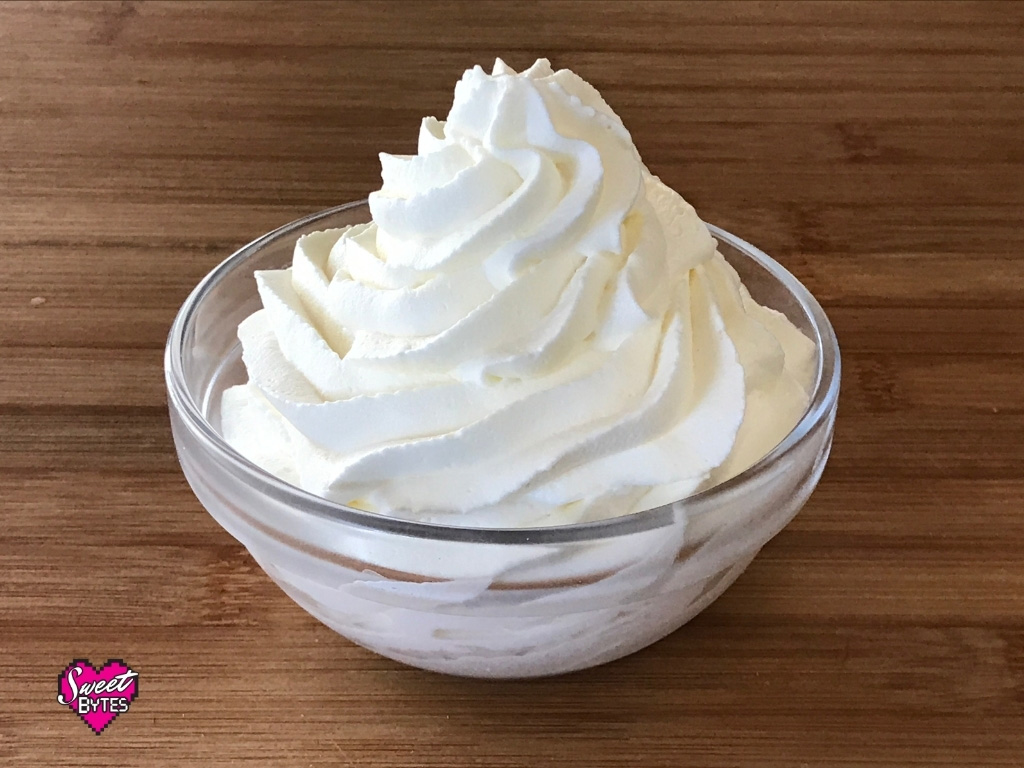
Swiss Meringue Buttercream:
AKA: SMBC, SMC, European Buttercream, Silky Buttercream, Swiss Buttercream
I also cannot speak for the Swiss-ness of this style of buttercream, but I will explain what it is.
Swiss Meringue Buttercream is made with egg whites, sugar, butter and flavoring. Heat egg whites and sugar in a double boiler until the mixture is very warm, and the sugar dissolves.
You can even use pasteurized egg whites from a carton to avoid separating eggs.
Whip the egg white mixture to stiff peaks. After the meringue cools, add butter in small chunks followed by flavoring.
My favorite recipe calls for added powdered sugar, but purists will stick with only the sugar added in the beginning. (Again, this is where secret recipes are gold. Everyone has tips and tricks that make their recipe special.) This type of buttercream is more stable in humidity and heat than American buttercream, but it will still melt in hot temps (just like any butter would.) You can sub some of the butter for shortening if you must have heat protection.
I learned how to make SMBC using free “Man About Cake” Craftsy classes! If you download the course materials, there are a ton of great recipes attached to each episode.
The pros of Swiss Meringue Buttercream:
- It is very smooth and silky feeling in the mouth
- Swiss Meringue is suitable for frosting, filling, or decorations.
- SMBC glides over the exterior of cakes like a dream
- Very nice for piping and can hold ruffles, borders, flowers, etc.
- Because it’s so stable, professional cake decorators prefer it or Italian Meringue Buttercream for all of their cakes
- It can be colored using AmeriColor Soft Gel Paste Colors
or other food-safe colorings
- Flavor easily using extracts, purees, emulsions, powders, zests, juices, liqueurs, etc.
- Works with fondant
- Refrigerate up to one week
- Frozen easily for later use
- It is stable at room temperature for several days
The Cons of Swiss Meringue Buttercream:
- You have to heat the egg whites and dissolve sugar. This takes patience.
- Meringue buttercreams have a learning curve.
- Special equipment makes the job easier. A candy thermometer, stand mixer, and a double boiler really help.
- You can break your SMBC by adding too much liquid. Breaking means it turns soupy.
- You can cook your egg whites if you aren’t paying attention while you are heating them
- It is more time-consuming to make a meringue buttercream than American Buttercream.
- Some people (lovers of American Buttercream) think it tastes too much like butter.
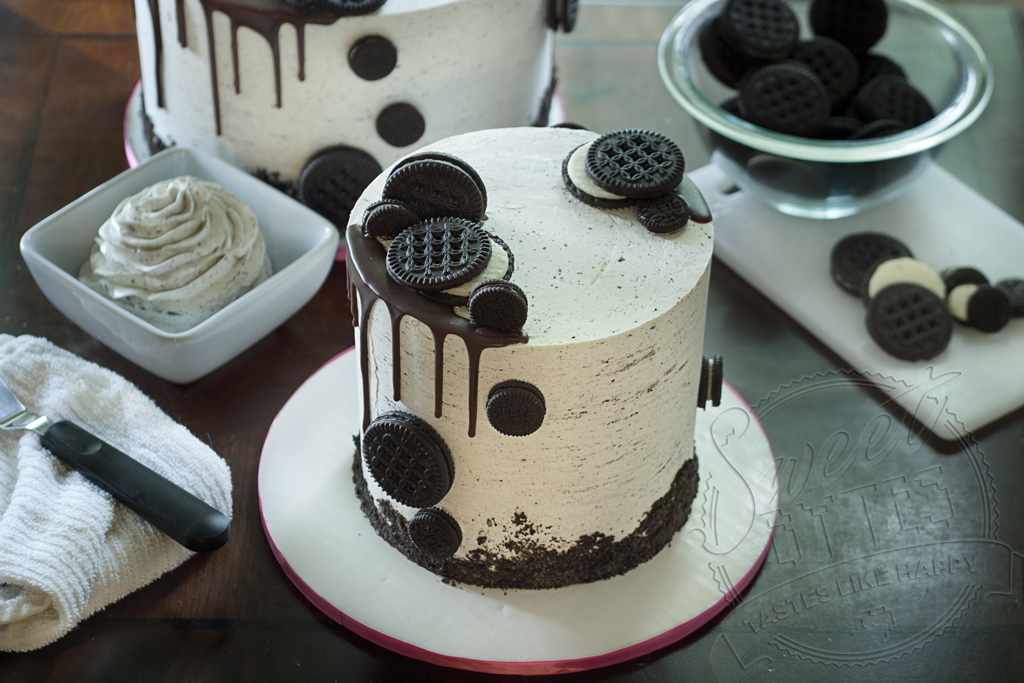
Did I leave your favorite types of frosting out?
If so, leave a comment or drop me a line! I also am excited to hear what are your favorite types of frosting and frosting pairings.
Mine is milk chocolate ganache with peanut butter buttercream and CHOCOLATE CAKE! I get a little drooly just typing about it.
